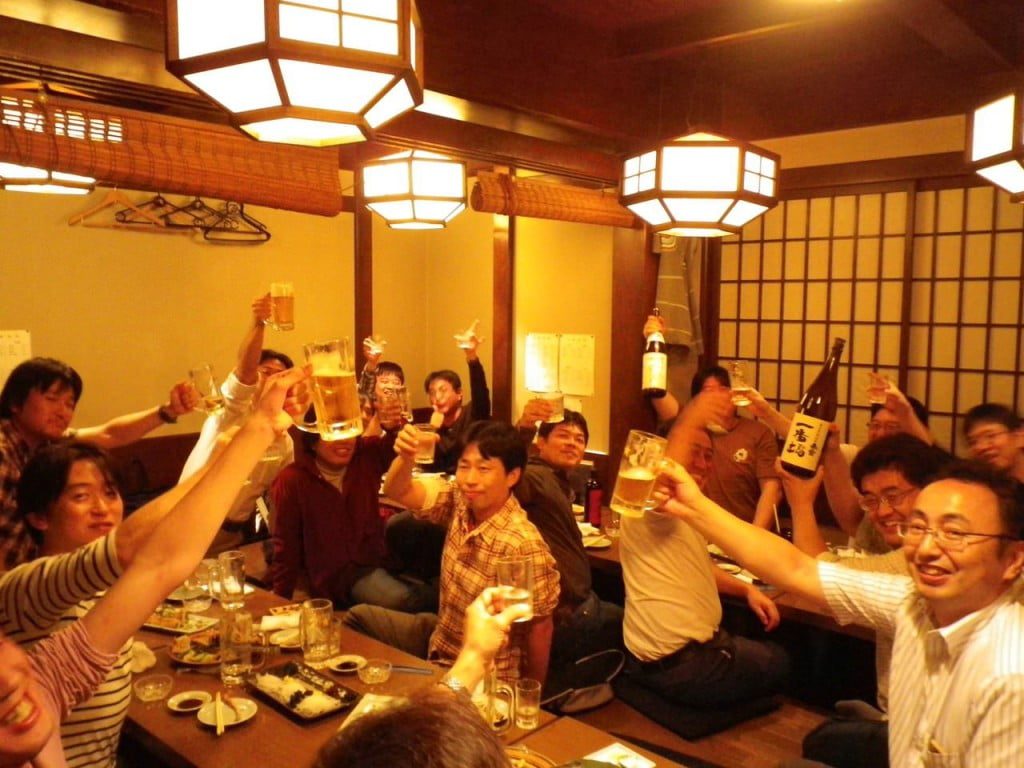Anyone who has ever had a few drinks with a person from Japan knows that quite often even a small amount of wine or brandy will quickly go to their heads – and this is equally true for men and women. There’s a simple explanation: the Japanese lack the enzyme that breaks down alcohol. A few of the symptoms we notice are intense grinning, getting red in the face, suddenly becoming sleepy, confused or dizzy, or suddenly losing their entire English vocabulary.
At the same time, we know that this is not true for all Japanese people. When meeting a person who can hold their liquor we discover – after politely asking, or possibly after being told by a third party – that this friend has been drinking alcohol regularly and for a long time and his or her body has clearly become accustomed to handling it. Of a man, he may have been helped along by an institution known as nomikai, which involves colleagues going off to drink together after work several times a week. This is an important part of Japanese work culture, allowing company staff and brass to get together in an informal atmosphere. While left unsaid, participation is expected. A Japanese colleague of mine remembers an old workmate at a previous job who was even less able to hold his liquor than the average. Then, when they met again a few years later after both had changed jobs, the friend proved to have learned to consume industrial quantities of booze without a problem.
So, those of you who think that “we’ll drink these Japanese under the table and get them to sign anything” will have to be careful. That tactic may well backfire. Obviously, home-distilled brandy with a 60 percent alcohol content is a nuclear option that might work against even the most experienced Japanese drinker, since our friends or business partners are rather unlikely to find Transylvanian Kosher Plum Brandy in the night clubs of Tokyo’s Roppongi district before flying to Hungary.
Perhaps healthy eating habits, serious self-control, and/or the use of Alcohol Killer and other regenerative beverages (“health drinks,” products halfway between energy drinks and medications) made according to secret Far Eastern recipes, combine to enable our Japanese friends to show up for work fit as a fiddle in freshly starched and ironed shirts just a few hours after a night on the town.
When I was in high school, I spent a year in Japan as an exchange student. I celebrated my 18th birthday there, which would have made me an adult in Hungary, but in Japan I was still underage. It was hard to accept that things were different. Over there you didn’t become an adult until 21, which was the legal drinking age. Maybe the absence of the enzymes to break down alcohol plays a role in this restriction. Young people in Japan aren’t given the chance to drink until much later than in Hungary.
Japan is a land of unusual things. Alcohol is one of those things. Assisting people with disabilities and affording equal opportunity is very important in Japan. Many manufacturers would like to give people with vision impairments the chance to realize that the beverage in their hand is alcoholic before it bites them. Therefore, they write the word “OSAKE” (alcohol) in Braille on the top of cans containing alcoholic beverages. Kirin Breweries took things one step further, writing “Beer” and the brand name “Kirin” on its beer. It is both a nice gesture and a good marketing ploy. Now, will the idea spread beyond Japan?
The pictures are illustrations from the following sources:
http://r.gnavi.co.jp/a201700/
http://www.barifuri.com/tourcenter/jyouhou/07_alcohol.html
http://maru9.at.webry.info/201201/article_12.html


